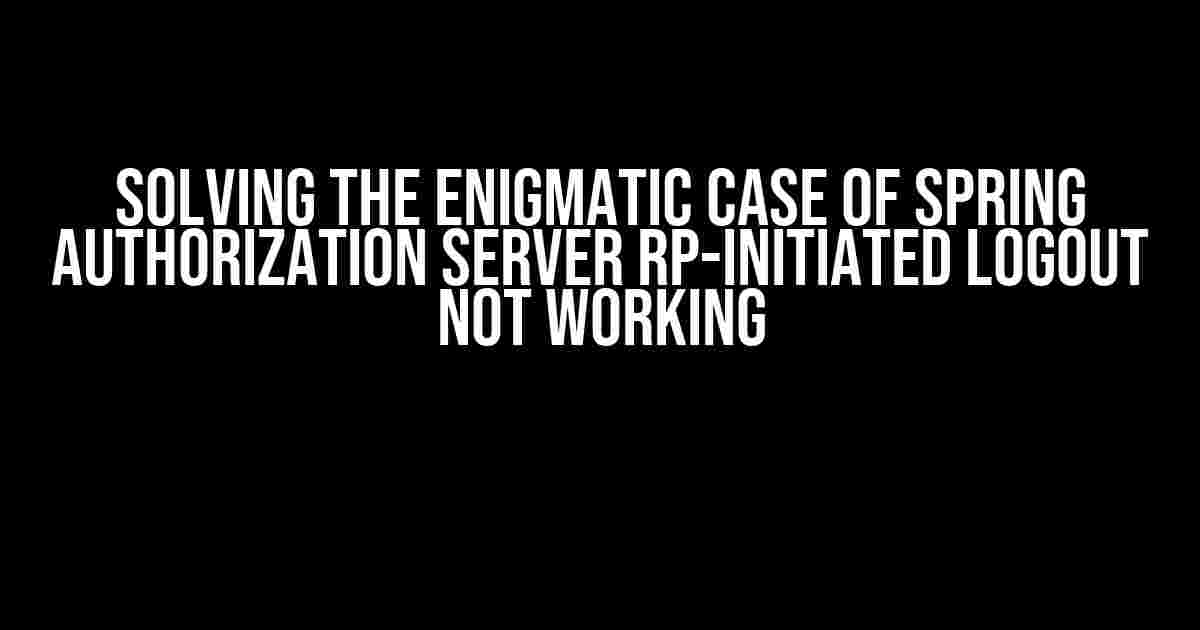Are you tired of banging your head against the wall trying to figure out why your Spring Authorization Server’s RP-initiated logout isn’t working? Well, buckle up, friend, because you’re about to embark on a thrilling adventure of discovery and troubleshooting!
The Mysterious Case of the Non-Functional Logout
Before we dive into the solution, let’s set the stage. You’ve got a Spring Authorization Server up and running, and you’ve implemented RP-initiated logout. Sounds simple, right? But, for some reason, when you try to log out, it’s as if the logout request is being swallowed by a black hole, leaving your users stuck in an infinite loop of frustration.
The Usual Suspects: Common Culprits Behind RP-Initiated Logout Issues
- Misconfigured Authorization Server : Maybe you accidentally copy-pasted some configuration from Stack Overflow without fully understanding the implications (we’ve all been there, right?).
- Incorrect Logout Endpoint : You might be hitting the wrong endpoint, or the endpoint might be misconfigured.
- Missing or Incorrect Parameters : Forget to pass the required parameters, or worse, pass the wrong ones.
- CORS Issues : Ah, the classic “my API is not responding to my requests” problem.
Step-by-Step Troubleshooting Guide
Let’s get our detective hats on and start investigating! Follow these steps to identify and fix the issue:
-
Verify Your Authorization Server Configuration
spring: security: oauth2: authorization: server: enabled: true logout: enabled: true url: /oauth2/logoutMake sure your `oauth2.authorization.server.enabled` and `oauth2.authorization.server.logout.enabled` properties are set to `true`. Also, double-check the `oauth2.authorization.server.logout.url` property points to the correct logout endpoint.
-
Check Your Logout Endpoint
@RestController @RequestMapping("/oauth2") public class LogoutController { @GetMapping("/logout") public void logout(HttpServletRequest request, HttpServletResponse response) { // Clear the security context SecurityContextHolder.clearContext(); // Invalidate the session request.getSession().invalidate(); // Redirect to the RP's logout page response.sendRedirect("/?logout"); } }Ensure your logout endpoint is correctly configured and handles the logout request as expected. You might need to customize this implementation to fit your specific use case.
-
Verify the RP’s Logout Request
Parameter Value post_logout_redirect_uri The URI the RP will redirect the user to after logout client_id The client ID of the RP Make sure the RP is sending the correct parameters in the logout request. Specifically, the `post_logout_redirect_uri` and `client_id` parameters are crucial for a successful logout.
-
Inspect the Network Requests
Use your browser’s developer tools to inspect the network requests during the logout process. Check for any errors or unexpected responses that might indicate the issue.
-
Check for CORS Issues
@Configuration public class CORSConfig extends WebMvcConfigurerAdapter { @Override public void addCorsMappings(CorsRegistry registry) { registry.addMapping("/**") .allowedOrigins("*") .allowedMethods("GET", "POST", "PUT", "DELETE") .maxAge(3600); } }Implement CORS configuration to allow cross-origin requests. This might be required if your RP and Authorization Server are running on different domains.
Bonus Round: Advanced Troubleshooting Techniques
If the above steps didn’t help, it’s time to break out the big guns!:
Enable Debug Logging
logging:
level:
org.springframework.security: DEBUGEnable debug logging for the Spring Security package to get more detailed information about the logout process.
Use a Debug Tool like Postman
Use a tool like Postman to simulate the logout request and inspect the response. This can help you identify any issues with the request or response.
Check the Server Logs
Review your server logs to identify any errors or exceptions related to the logout process. This might give you a hint about what’s going wrong.
Conclusion
Troubleshooting RP-initiated logout issues in Spring Authorization Server can be a daunting task, but with the right approach, you can identify and fix the problem. By following this step-by-step guide, you’ll be well-equipped to tackle even the most stubborn logout issues.
Remember, the key to successful troubleshooting is to be methodical, patient, and thorough. Don’t be afraid to try new things, and don’t hesitate to seek help if you’re stuck. Happy troubleshooting!
And, who knows, maybe one day you’ll be the one helping others solve the enigmatic case of the non-functional logout.
Frequently Asked Question
Get answers to the most commonly asked questions about Spring Authorization Server RP-initiated logout not working.
Q1: What is RP-initiated logout and why is it not working in my Spring Authorization Server?
RP-initiated logout is a mechanism that allows a relying party (RP) to initiate a logout request to the authorization server. If it’s not working in your Spring Authorization Server, it might be due to incorrect configuration or missing endpoint implementation. Check your config and make sure you’ve implemented the necessary endpoints, such as the `/logout` endpoint.
Q2: How do I configure RP-initiated logout in my Spring Authorization Server?
To configure RP-initiated logout, you need to add the `@EnableOAuth2Sso` annotation to your Spring Security configuration class and implement the `logout` endpoint. You also need to configure the `OAuth2LogoutSuccessHandler` to handle the logout request.
Q3: What is the difference between RP-initiated logout and OP-initiated logout?
RP-initiated logout is when the relying party (RP) initiates the logout request, whereas OP-initiated logout is when the OpenID Connect Provider (OP) initiates the logout request. In RP-initiated logout, the RP sends a logout request to the OP, whereas in OP-initiated logout, the OP sends a logout request to the RP.
Q4: How do I handle the logout request in my relying party (RP) application?
To handle the logout request in your RP application, you need to send a request to the authorization server’s `/logout` endpoint and include the `post_logout_redirect_uri` parameter with the URL that the user should be redirected to after logout. You should also clear the user’s session and remove any tokens or authentication-related data.
Q5: What are some common issues that can cause RP-initiated logout to not work in Spring Authorization Server?
Some common issues that can cause RP-initiated logout to not work in Spring Authorization Server include incorrect configuration, missing or misconfigured endpoints, invalid or expired tokens, and incorrect handling of the logout request in the RP application. Make sure to double-check your configuration and implementation to resolve these issues.

